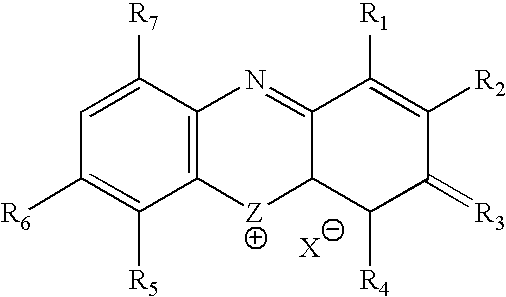Methylene Blue Therapy of Parasitic Infections
- Summary
- Abstract
- Description
- Claims
- Application Information
AI Technical Summary
Benefits of technology
Problems solved by technology
Method used
Image
Examples
Embodiment Construction
1. Therapeutic Compositions
[0008] Thiazine Dyes
[0009] Examples of useful thiazine dyes includes, but are not limited to, methylene blue, methyl methylene blue, dimethyl methylene blue, azure A, azure B, azure C, methylene green, new methylene blue. Taylor's Blue, Toluidine Blue O, and thionine. Methylene blue is the preferred dye. These dyes are all commercially available from a number of different sources. Symmetrical 3,7-bis(dialkyl amino)phenothiazin-5ium derivatives which may be useful are described in Moura et al., Current Drug Targets, Vol. 4, 133-141 (2003).
Methylene Blue and Its Derivatives
[0010] Methylene blue, 3,7-bis(dimethylamino)-phenothiazin-5-ium chloride, C16H18ClN3S, is a dark green or blue thiazine dye which was first isolated in 1876. Methylene blue is a thiazine dye occurring as dark blue-green crystals which is soluble in water and sparingly soluble in alcohol, forming deep blue solutions. Methylene blue injectable has a pH of 3-4.5. The pKa is between 0 an...
PUM
| Property | Measurement | Unit |
|---|---|---|
| Mass | aaaaa | aaaaa |
Abstract
Description
Claims
Application Information
 Login to View More
Login to View More - R&D
- Intellectual Property
- Life Sciences
- Materials
- Tech Scout
- Unparalleled Data Quality
- Higher Quality Content
- 60% Fewer Hallucinations
Browse by: Latest US Patents, China's latest patents, Technical Efficacy Thesaurus, Application Domain, Technology Topic, Popular Technical Reports.
© 2025 PatSnap. All rights reserved.Legal|Privacy policy|Modern Slavery Act Transparency Statement|Sitemap|About US| Contact US: help@patsnap.com

